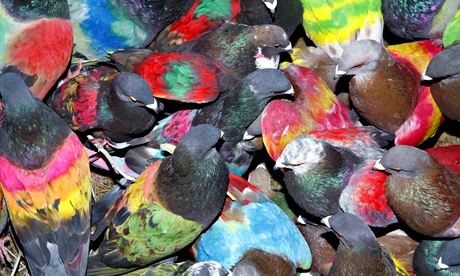
Paloma al Aire looks more like a scrapbook than a photobook. Its spiral-bound cardboard cover shows brightly coloured birds in flight against a white background and a small cut-out through which a glum middle-aged man peers. He is, as the next image reveals, standing in a field, cradling a box that holds his prize racing pigeon.
It is a mischievously drab opening shot for this surreal look at the racing pigeon culture of Valencia and Murcia in Spain, where breeders paint their birds in garish colours and release them to chase after a lone female. The pigeon that spends most time in her winged company wins.
Ricardo Cases first published Paloma al Aire – Dove Into the Air – in a very limited run in 2011, when it was one of the most talked-about photobooks at Arles photography festival. It has since been included in Martin Parr & Gerry Badger's The Photobook Vol 3, making that first edition even more sought-after. Why it has taken so long to publish a second edition is anyone's guess, but it remains an eccentrically brilliant piece of work that shows the oddness of this all-male pursuit without patronisation or romanticism.
At first, it is the hand-painted pigeons that hold your gaze – but the men who breed and race them fascinate Cases even more. There is such local prestige attached to owning a champion bird, hence the seriousness with which they pursue their hobby. From the ground, the men follow the flight of their individual pigeons – easily recognisable by colour – urging them on and rescuing them if, as often seems to be the case, they land on treetops or tall buildings or electric wires for a breather. Cases's decision to follow the antics of the owners rather than the birds allows us a glimpse of their obsessive, and unconsciously absurd, ways. He snaps one man precariously climbing a wall in search of a recalcitrant bird, and another crouching as a flock of the colourful pigeons swoop towards him.
Throughout the action, he places static, posed shots that show the men cradling their prize pigeons – one man holds a bird while a second is tucked inside his shirt; another shelters an egg in his palm.
To make things even more surreal, Cases often crops his images so we see only a torso or a pair of hands wrapped around a bird. In one such portrait, the ring-binding runs vertically down a man's cardigan like a zipper. Throughout, the colours are saturated so that everything seems unreal. In one photograph, a flock of DayGlo birds gather under a tree at dusk like invaders from some imagined tropical paradise. Were it not documentary reportage, this could be staged conceptualism.
Paloma al Aire is an irreverent homage to an extravagant, old-fashioned male ritual that may have its roots in the courtliness and machismo of a much older Spain. "None of them ever gets too intimate," runs the blurb on the publisher's site, referring to the male pigeons, "but the winner is the one that spends the most time close to her. The winner is not the most athletic, the toughest or the purest in breed but the more courteous, the one showing more constancy and having the strongest reproductive instinct. The macho." An odd, and oddly revealing, book, then, about the behaviour of pigeons and the men who breed them.
• On show as part of Publish/Curate at TJ Boulting, London W1W, until 24 August.

